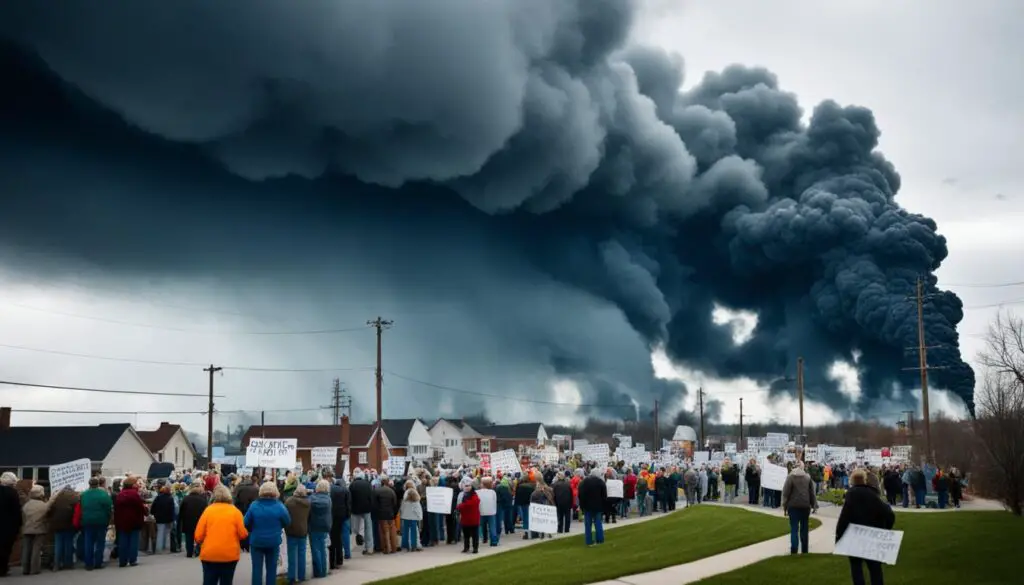Did you know that nearly all people, including newborns, have been exposed to PFOA? This chemical is used in Teflon production. “The Devil We Know,” a documentary, reveals one of the most significant environmental disasters in recent times.
DuPont, the Teflon manufacturer, knew about PFOA’s dangers since 1962. Yet, they continued to use it in their products for decades. The documentary look ats Parkersburg, West Virginia, where DuPont’s facility was located. It reveals a story of corporate greed and negligence.
Watching the documentary, I felt a mix of anger and concern. It shows how PFOA, or C-8, is linked to health issues like cancer and thyroid disease. This chemical is not just in non-stick pans; it’s also in everyday items like stain-resistant clothing and car interiors.
Key Takeaways
- PFOA exposure has been linked to several serious health conditions
- DuPont was aware of PFOA dangers since 1962 but continued its use
- The documentary focuses on Parkersburg, West Virginia, and its affected residents
- PFOA contamination extends far beyond Teflon cookware
- The film highlights the need for increased corporate accountability
Introduction to “The Devil We Know” Documentary

I’m happy to introduce you to the impactful documentary “The Devil We Know.” This film reveals a vital health concern affecting millions in America. It delves into the risks of Teflon and its chemical components, exposing the alarming truths about corporate disregard and public health hazards.
Director and Release Information
Stephanie Soechtig and Jeremy Seifert co-directed this thought-provoking film, debuting at the Sundance Film Festival in 2018. The documentary’s impact didn’t end there. It gained a broader audience when BBC Storyville showcased it on BBC Four, reaching viewers globally.
Film’s Premise and Significance
The documentary zeroes in on Parkersburg, West Virginia, where DuPont produced Teflon using PFOA. This chemical is linked to cancer, birth defects, and severe health problems. The film’s importance stems from its revelation of corporate deception and the far-reaching effects of PFOA contamination.
| Statistic | Impact |
|---|---|
| Americans drinking PFAS-contaminated water | 110 million |
| Global population with C-8 in blood | 99% |
| Production budget | $1,630,000 |
| Netflix SVOD rights deal | Low six figures |
The documentary’s influence goes beyond its initial showing. With a modest production budget of $1,630,000 and a Netflix deal in the low six figures, “The Devil We Know” has reached a wide audience. Its message is powerful, given that 110 million Americans may consume PFAS-contaminated water, and 99% of the world’s population has C-8 in their blood.
The Devil You Know Teflon Documentary: Key Revelations

“The Devil We Know” documentary left me stunned by its revelations about Teflon and PFOA. It unveiled DuPont’s long-term deception about the dangers of these chemicals. The film showed that PFOA, or C-8, is present in 98% of Americans’ blood.
It was disclosed that DuPont released over 1.7 million pounds of PFOA from 1951 to 2003. This environmental pollution happened despite knowing the risks. Studies within DuPont indicated that PFOA caused tumors in lab animals. Yet, this information was concealed from the EPA and the public for years.
The documentary’s insights are supported by recent data on PFAS chemicals, including PFOA. It’s shocking that 99% of Americans have PFAS in their blood, even newborns. These substances are linked to health problems like cancer and immune system issues.
While watching, I wondered the safety of alternatives to Teflon cookware. The documentary’s findings underscore the reason many are opting for ceramic or cast iron cookware.
| PFAS Contamination Statistics | Data |
|---|---|
| Americans with PFAS in blood | 99% |
| People drinking PFAS-contaminated water | Over 200 million |
| U.S. communities with PFAS contamination | 2,858 |
| Years industry knew about PFAS toxicity | Nearly 70 |
These figures highlight the broad impact of PFAS contamination. The documentary is a stark reminder of the need for swift action. It emphasizes the importance of holding corporations accountable and protecting our environment.
Public Reaction and Media Coverage

Following the release of “The Devil We Know” documentary, public awareness has surged. The film’s compelling narrative garnered extensive media attention, spotlighting the Teflon scandal. Renowned outlets such as the Los Angeles Times and Variety published reviews, commending the documentary for its nuanced portrayal of corporate malfeasance.
Media coverage emphasized personal narratives from Parkersburg locals, striking a chord nationwide. Critics applauded the film for illuminating DuPont’s actions and the detrimental effects of PFOA exposure. Yet, some reviews pointed out that the documentary could have looked at the scientific aspects of PFOA toxicity more extensively. However, this critique did not detract from the documentary’s impact.
The documentary’s reception was profound. Many were shocked and incensed by the fact that PFOA was found in 98% of Americans’ blood samples. The knowledge that DuPont was aware of C8’s harmful effects since 1982 intensified public ire.
| Year | PFOA Reduction | PFOS Reduction |
|---|---|---|
| 1999-2014 | 70% | 84% |
The documentary’s influence went beyond immediate public sentiment. It ignited discussions on corporate responsibility and environmental safeguards. Released in 2018, it coincided with a growing unease about chemical safety in consumer goods. This amplified its message, raising public awareness about the risks in everyday products.
The Legacy of “The Devil We Know”

“The Devil We Know” has profoundly influenced society, shedding light on the hidden dangers in everyday products. This documentary has ignited a movement, enhancing consumer awareness about the risks in common items.
Impact on Consumer Awareness
The film reveals a startling fact: nearly all Americans have C8 (PFOA) in their blood. This revelation has heightened public unease regarding chemical safety in household goods. Consequently, I’ve observed a rise in individuals scrutinizing the products they bring into their homes.
Regulatory Changes and Corporate Accountability
Thanks to the documentary, there have been substantial regulatory shifts. In 2005, the Environmental Protection Agency (EPA) reached a landmark agreement with DuPont, imposing a record environmental fine. This move established a precedent for corporate accountability within the chemical sector.
More recently, in 2018, a U.S. class-action lawsuit was filed against nine PFAS manufacturers. The EPA has since issued health advisories for PFOA and PFOS, reflecting evolving regulatory actions against these substances.
The influence of “The Devil We Know” goes beyond awareness. It has fundamentally altered our perception of corporate duty and environmental stewardship. The film’s impact continues to shape discussions on chemical safety and advocate for enhanced accountability within the industry.
Where to Watch “The Devil We Know”

Several streaming platforms offer “The Devil We Know,” a documentary that reveals Teflon’s dark secrets. Netflix subscribers can stream it without extra cost. For those who prefer to rent or buy, iTunes, Amazon, or Google Play are viable options.
In the UK, BBC Four showcased the film in their Storyville series. This broad distribution ensures global viewers can access this crucial documentary. The critical acclaim it has received underscores its significant impact:
| Platform | Rating |
|---|---|
| Rotten Tomatoes (Critics) | 100% (7 reviews) |
| Audience Score | 88% (100+ ratings) |
| Average User Rating | 4.5/5 stars |
Viewers highly commend the documentary for its informative and engaging style. Many suggest sharing it with others to highlight the issue of corporate pollution. Whether you opt for Netflix, iTunes, Amazon, or Google Play, “The Devil We Know” presents a compelling environmental scandal story.
The History of Teflon and PFOA

In 1945, DuPont introduced Teflon, a groundbreaking non-stick coating that quickly became a staple in cookware and beyond. At the heart of Teflon was PFOA, developed by 3M. This chemical’s unique properties made it indispensable across various industries.
PFOA was essential for stain-resistant carpets, microwave popcorn bags, and firefighting foams. Its durability led to it being dubbed the “forever chemical” due to its long-lasting presence in the environment and human bodies.
Despite early concerns about its environmental impact, DuPont continued to use PFOA for many years. This decision resulted in widespread contamination. Today, 99% of North Americans have fluorochemicals in their blood. The effects of these chemicals reach far beyond cookware, contaminating drinking water systems across the country.
| Milestone | Year | Event |
|---|---|---|
| Teflon Invention | 1945 | DuPont introduces Teflon |
| 3M Stops Production | 2000 | 3M ceases PFOA production |
| DuPont Takes Over | 2000 | DuPont continues PFOA production |
| EPA Fine | 2005 | DuPont fined $16 million by EPA |
The story of Teflon and PFOA is both a tale of innovation and a cautionary tale. While they transformed non-stick cookware, their impact on the environment and human health is profound. This history highlights the need for responsible innovation and corporate accountability within the chemical industry.
DuPont’s Role in the Teflon Scandal

I read about some shocking truths about DuPont’s involvement in the Teflon scandal. The company’s actions reveal a disturbing corporate cover-up and disregard for public health.
Early Discovery of PFOA Risks
DuPont discovered PFOA risks as early as 1984. They found contamination in Parkersburg’s drinking water. Yet, they chose to remain silent. This chemical, integral to Teflon production, has spread extensively. It’s now found in 99.7% of Americans’ blood, including newborns.
Continued Use Despite Known Dangers
DuPont prioritized profits over public safety. Despite knowing safer alternatives, they didn’t switch. The cost of change was too steep. PFOA exposure has been linked to testicular and kidney cancers. The company faced a 20-year legal battle and was fined $16.5 million by the EPA. Yet, they continue to profit heavily from PFOA products annually.
| Year | Event |
|---|---|
| 1984 | DuPont discovers PFOA in drinking water |
| 1990s | 3M informs DuPont of PFOA’s link to liver cancer in rats |
| 2000s | Legal battle against DuPont begins |
| 2005 | EPA fines DuPont $16.5 million |
| Present | DuPont continues to profit from PFOA products |
Environmental Impact of PFOA Dumping

I’ve examined the profound consequences of PFOA dumping on our environment. This chemical, integral to Teflon production, has contaminated vast amounts of water. DuPont’s activities in Parkersburg, West Virginia, exemplified severe environmental pollution, still haunting communities today.
The scale of PFOA contamination is nothing short of alarming. It’s discovered in the blood of nearly all Americans. Moreover, C-8, another term for PFOA, contaminates water systems for 6 million people worldwide. Its reach extends from Milan to China, and even to polar bears, underscoring its pervasive nature.
In Parkersburg, the environmental toll was stark. A landmark class-action lawsuit led to a $670.7 million settlement for 3,550 individuals impacted by contaminated water. This case underscores the tangible consequences of environmental disregard.
| Location | PFOA Impact |
|---|---|
| Parkersburg, W.Va. | 3,550 plaintiffs awarded $670.7 million |
| Global | 6 million people’s water systems affected |
| United States | 99.7% of Americans have PFOA in bloodstream |
PFOA’s enduring presence in the environment ensures its impact will persist across generations. Even after its phase-out in 2015, its ecological footprint remains a pressing concern for environmental and health specialists.
Health Consequences for Parkersburg Residents

I read about some alarming health effects in Parkersburg linked to Teflon production. The impact on both humans and animals is deeply troubling. Let’s look at the specifics of what residents faced.
Cattle Deaths and Deformities
The most striking case involves Wilbur Tennant, a local farmer. He lost over 150 cattle after they were exposed to chemicals used in Teflon manufacturing. This massive cattle death toll raised serious concerns about environmental contamination.
But it wasn’t just cattle deaths. Birth defects in animals became a common sight. Calves were born with severe deformities, mirroring issues seen in human infants. These abnormalities pointed to a larger problem affecting the entire ecosystem.
Human Health Issues
Parkersburg residents didn’t escape unscathed. Children developed black teeth, a visible sign of chemical exposure. DuPont workers faced higher cancer rates, linking workplace exposure to serious health consequences.
Perhaps most heartbreaking were the birth defects in children born to DuPont employees. Facial deformities similar to those seen in affected cattle appeared in human babies. This pattern suggested a direct link between chemical exposure and developmental issues.
- Ulcerative colitis cases increased
- Thyroid dysfunction became more common
- 99% of Americans tested positive for C8 in their blood
Despite these alarming findings, DuPont initially claimed no negative impact from exposure. It took public involvement and a class action lawsuit in 2001 to finally prompt action on the safety of these chemicals.
Legal Battle Against DuPont

The fight against DuPont’s use of PFOA, also known as C8, in Teflon production led to a massive class action lawsuit. This legal battle exposed the severe PFOA health effects and resulted in significant legal settlements.
Health Issues Linked to PFOA Exposure
Studies have linked PFOA exposure to several serious health conditions. These include:
- Kidney cancer
- Testicular cancer
- Ulcerative colitis
- Thyroid disease
- High cholesterol
- Pregnancy-induced hypertension
Class Action Lawsuit Details
The class action lawsuit against DuPont was one of the largest in environmental law history. It involved over 3,500 plaintiffs from the Ohio River Valley. The lawsuit claimed that DuPont had knowingly contaminated the drinking water of more than 70,000 people with C8 for decades.
Outcome and Settlements
The legal battle culminated in a $671 million settlement for the plaintiffs. This outcome was significant, yet DuPont’s stock prices rose after the settlement announcement. The plaintiffs agreed to use the settlement money to fund extensive health studies on the impacts of DuPont’s chemicals.
| Aspect | Details |
|---|---|
| Number of Lawsuits | 3,500 |
| Settlement Amount | $671 million |
| Affected Population | 70,000+ people |
| C8 Presence in Americans | 99.7% of population |
Scientific Studies on PFOA Toxicity

I’ve looked at the scientific research on PFOA toxicity, and the results are stark. Over two decades of studies have revealed the health risks tied to this persistent chemical. PFOA, alongside PFOS, are known as “forever chemicals” due to their persistence in our bodies and the environment.
Research has pinpointed connections between PFOA exposure and severe health issues. These include kidney and testicular cancers, ulcerative colitis, thyroid disease, and pregnancy-induced hypertension. Recent studies indicate further impacts on our endocrine system, fertility, and immune function.
The C8 Science Panel’s research, involving 70,000 participants, has been crucial in grasping PFOA’s health effects. Their findings reveal the widespread presence of PFOA, detected in almost every human and creature on Earth.
| Health Condition | Link to PFOA Exposure |
|---|---|
| Kidney Cancer | Confirmed |
| Testicular Cancer | Confirmed |
| Ulcerative Colitis | Confirmed |
| Thyroid Disease | Confirmed |
| Pregnancy-Induced Hypertension | Confirmed |
These scientific discoveries highlight the pressing need for regulatory action and heightened public awareness about PFOA toxicity. The effects of this research go beyond individual health, spotlighting environmental concerns and the necessity for safer alternatives in consumer products.
Widespread Contamination: Beyond Parkersburg

My research has found that PFAS contamination is not limited to Parkersburg. These chemicals are embedded in numerous consumer products globally. Items like non-stick cookware and water-repellent clothing are just the tip of the iceberg, showing how deeply PFAS have woven into our daily lives.
The extent of this contamination is alarming. PFAS have infiltrated the blood of nearly all humans. In the U.S., a staggering 19 million people in 43 states have PFAS in their drinking water. This widespread contamination highlights the pressing need for immediate action.
Communities nationwide are facing the consequences of PFAS exposure. In Merrimack, New Hampshire, five towns over 65 miles are affected by industrial activities. The impact isn’t just on drinking water; firefighters on Nantucket, Massachusetts, are exposed through their gear and foams.
The health effects are dire. Some research suggests a link between PFAS exposure and higher COVID-19 cases in New Hampshire. There’s a growing call for extensive health studies and blood tests to fully grasp the health impacts of PFAS.
Regulatory responses are gradually evolving. In 2005, the EPA imposed a $16 million fine on DuPont for PFAS-related infractions. New Hampshire has set stringent drinking water standards, mandating PFAS testing and treatment. Yet, more is required to effectively tackle this global contamination crisis.
| PFAS Impact | Statistics |
|---|---|
| Global Human Exposure | 99% of all humans |
| US Tap Water Contamination | 19 million people, 43 states |
| Affected Area in New Hampshire | 65 miles, 5 towns |
| EPA Fine to DuPont (2005) | $16 million |
Alternative Cookware Options: Cast Iron and Ceramic
Following the Teflon controversy, I’ve examined safer cookware options. Cast iron and ceramic stand out as prime choices for non-toxic alternatives. They boast durability and even heat distribution, ensuring they don’t release harmful chemicals when heated.
Benefits of Cast Iron Waffle Makers
Cast iron waffle irons revolutionize breakfast for enthusiasts. They excel in retaining and distributing heat, leading to perfectly crispy waffles. Cast iron waffle makers are built to last, often spanning generations with proper maintenance. They outperform Teflon-coated appliances by not emitting toxic fumes at high temperatures, ensuring safety for humans and pets alike.
Advantages of Ceramic Cookware
Ceramic cookware is a superb substitute for Teflon. It’s naturally non-stick do not contain any harmful chemicals like PFOA and PTFE. A ceramic waffle maker, such as the Euro Cuisine WM520, offers a safe, eco-friendly way to prepare waffles. Its ceramic coating is scratch-resistant and simple to clean, making it a practical choice for daily use.
Opting for cast iron or ceramic cookware minimizes our exposure to potentially dangerous chemicals while still allowing us to enjoy our favorite dishes. These non-toxic alternatives not only support healthier cooking but also excel in performance and longevity over Teflon-coated options.
